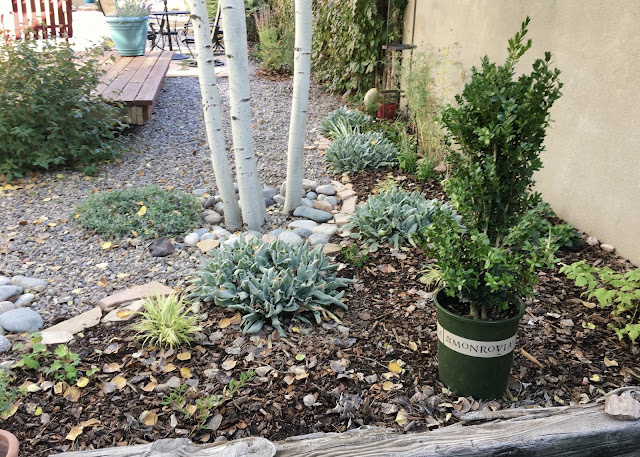Experiments
It isn't actually gardening here, it's more like experimenting. And by experimenting I mean wild-ass random guessing as to how plants will perform in defiance of what their plant tags say.
Plant tags are written for general gardening in wet, eastern or midwest conditions. So a plant for my coldness zone that says "drought tolerant" on the tag, simply isn't here. Probably isn't even okay with twice weekly watering. The plant tag is useless, so we have to experiment.
"Full sun" on the tag often means shade in the strong UV light at 7,000 feet. But not always, you have to experiment.
Plant profiles or descriptions online aren't much better. They too are written for gardens in other climates, and even the ones specifically written for southwest plants often mean "desert". They're for hot Arizona, not the high, cold, montane environment we have. Again, randomly planting things and seeing how they do is the gardener's best path.
This leads me to my most recent experiment: a boxwood.
 |
| Buxus 'Green Tower', a columnar, narrow boxwood to hide the potting bench |
It will grow in some shade, but here I think it will need the all day deep shade I have in the garden behind the aspens. The plant tag says it needs full sun.
Profiles say boxwood wants alkaline soil -- the plant tag says slightly acidic. I have high ph dirt that has been amended, so I'm covering both bases.
Leaf burn in winter can happen with boxwoods. This spot is protected up against the wall, so my experiment will be to see if the leaves come through winter unscorched. Profiles for 'Green Tower' boxwood say it is less susceptible to burn, but again, that's written for wet climates. The air is dry here in winter and spring, very dry. It's a guess to see whether it browns despite the profile's promise.
At this back corner I wanted something to screen the potting bench behind. There are low moundy plants with blue or golden foliage (and some plants yet to fill in) but nothing dark green or tall.
 |
| Lots of low plants in front but no height or density toward the back of this garden. |
Boxwood is not a southwest native, obviously. But, like roses, this classically English-adapted plant may do well here, I'll have to see.
I'm
If I was a boxwood, I'd be very very afraid.

Comments